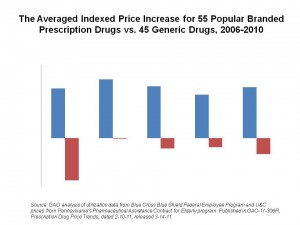 The Federal government covers about $1 in every $3 of spending on prescription drugs in the U.S. That equates to $78 bn of the total $250 bn spent on Rx in 2009. Between 2006 and 2010, the indexed cost of the usual and customary price for commonly used branded prescription drugs grew by 8.3%; in that period the price of commonly used generic drugs fell by 2.6%. The General Accounting Office (GAO), those nonpartisan bean-counters in Washington DC, analyzed pricing trends of prescription drugs over the most recent five years, based on changes from first quarter to first quarter in each subsequent year.
The Federal government covers about $1 in every $3 of spending on prescription drugs in the U.S. That equates to $78 bn of the total $250 bn spent on Rx in 2009. Between 2006 and 2010, the indexed cost of the usual and customary price for commonly used branded prescription drugs grew by 8.3%; in that period the price of commonly used generic drugs fell by 2.6%. The General Accounting Office (GAO), those nonpartisan bean-counters in Washington DC, analyzed pricing trends of prescription drugs over the most recent five years, based on changes from first quarter to first quarter in each subsequent year.
The GAO also compared drug price increases to the broader consumer price index for medical goods and services, the medical CPI — which includes both prescription and nonprescription drugs, medical equipment and health services. The medical CPI between 2006-2010 was 3.8%.
Double-digit price increases were found in 15 commonly-prescribed brand drugs. The greatest percentage increase among the commonly used Rx brands was found to be Flomax, which increased an average of 17.6% between 2006-2010, followed by Ambien (15.3%), Clarinex (12.5%), Premarin (12.2%), Altace (11.6%), Effexor (11.2%), Lantus (11.1%), and Lotrel (11.1%). The smallest price increase in the 5-year period was found in Zocor, with a 2.2% price increase.
GAO created several market baskets of drugs for this analysis. The chart illustrates the price trends for the market basket containing both branded and generic drugs based on the Blue Cross Blue Shield Federal Employee Program utilization data of 55 commonly used branded drugs and 45 commonly used generics — based on the active ingredient in the drug, and not just the drug name.
Drugs in this market basket from A to Z ranged from Alendronate sodium (generic Fosamax) and Allopurinol (generic Lopurin and Zyloprim for gout) to Warfarin (generic Coumadin) and Zolpidem tartrate (generic Ambien).
Health Populi’s Hot Points: As $1 in $3 spent on Rx drugs is paid by the U.S. Federal government, it’s important to remember where those monies are coming from: taxpayers. As this portion of the medical price index is increasing faster than other goods in the medical goods-and-services basket, this finding should give American taxpayers pause.
As more branded pharmaceutical products come off-patent over the next several years, generics will continue to be the high-value-add portion of the medical CPI. Pharmaceutical industry analysts call this era the “patent cliff:” that is, the trend of blockbuster ($1 billion brands) and other drugs going off-patent leading manufacturers with lean pipelines’ fortunes to decline.
But at the same time, in the U.S. health economic game that is akin to whack-a-mole, there are short-term fiscal winners: consumers (in particular, older Americans who consumer proportionately more drugs than younger health citizens), private employers who foot the bill for workers’ prescription drug plans, and of course, taxpayers.
In the longer term, the non-transparent Rx pricing game, with intermediary PBMs and arcane rebate formulae, needs overhauling. And, of course, patients and physicians would greatly benefit from some greening of the pharmaceutical portfolio for new-new therapies of high value.




 Thank you, Jared Johnson, for including me on the list of the
Thank you, Jared Johnson, for including me on the list of the  I am so grateful to Tom Lawry for asking me to pen the foreword for his book, Health Care Nation,
I am so grateful to Tom Lawry for asking me to pen the foreword for his book, Health Care Nation,  Thanks to Feedspot for naming this blog, Health Populi, as a
Thanks to Feedspot for naming this blog, Health Populi, as a